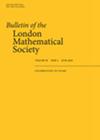On Poincaré polynomials for plane curves with quasi-homogeneous singularities
IF 0.9
3区 数学
Q2 MATHEMATICS
引用次数: 0
Abstract
We define a combinatorial object that can be associated with any conic-line arrangement with ordinary singularities, which we call the combinatorial Poincaré polynomial. We prove a Terao-type factorization statement on the splitting of such a polynomial over the rationals under the assumption that our conic-line arrangements are free and admit ordinary quasi-homogeneous singularities. Then we focus on the so-called -arrangements in the plane. In particular, we provide a combinatorial constraint for free -arrangements admitting ordinary quasi-homogeneous singularities.



拟齐次奇异平面曲线的poincarcarr多项式
我们定义了一个组合对象,它可以与任何具有一般奇点的圆锥线排列相关联,我们称之为组合庞卡罗多项式。在我们的圆锥线安排是自由的并且允许一般拟齐次奇点的假设下,我们证明了一个关于这种多项式在有理数上的分裂的terao型分解命题。然后我们关注所谓的平面上的d$ d$排列。特别地,我们提供了一个允许普通拟齐次奇点的自由d$ d$排列的组合约束。
本文章由计算机程序翻译,如有差异,请以英文原文为准。
求助全文
约1分钟内获得全文
求助全文
来源期刊
CiteScore
1.90
自引率
0.00%
发文量
198
审稿时长
4-8 weeks
期刊介绍:
Published by Oxford University Press prior to January 2017: http://blms.oxfordjournals.org/

 求助内容:
求助内容: 应助结果提醒方式:
应助结果提醒方式:


